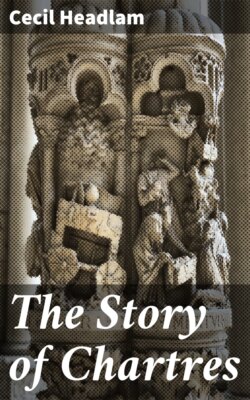Читать книгу The Story of Chartres - Cecil Headlam - Страница 11
На сайте Литреса книга снята с продажи.
The Veil of the Virgin—The Cathedral Treasury.
ОглавлениеTable of Contents
Three years later Charles-le-Chauve, paying one of his frequent pilgrimages to the shrine which he afterwards described as the first seat of the Virgin in France, beheld the ravages of Hastings. Partly perhaps as a consolation to the inhabitants for their losses, he now made their church the depository of one of the most precious relics of the Virgin known to Christendom—her veil or inner vestment, presented[24] by the Empress Irene to the Emperor Charlemagne at Constantinople. It is and was known as the Sancta Camisia, or, in popular parlance, the Sainte Tunique or Chemisette. Hence the form by which it is represented in the arms of the chapter and in the innumerable emblems which from the thirteenth century onwards have been prepared in metal or ware as tokens for the pious pilgrim. The immediate result of the possession of this sacred veil and the miracles it wrought was an influx of pilgrims to Chartres, who brought wealth enough to enable the Bishop Gislebert to restore the ruined church. He would seem to have still followed the lines of Castor’s church, but he extended it eastwards, over and beyond the Gallo-Roman wall, raising the new sanctuary of the choir so that the floor was two or three yards higher than that of the nave, as in the case of the Church of S. Martin-au-Val, and constructing out of the martyrium a crypt where the veil might be kept safe in the time of danger.
It was not long, if we may believe the chroniclers, before the love and reverence with which all the inhabitants regarded this relic was to be justified and the reputation of the veil as the palladium of the town established.
It was in the year 911 that the Northmen, who had now come to regard Neustria as their own, burst for the last time on the land of France. The people of La Beauce fled to the forests and the churches for refuge; but the forests were soon in flames and the churches were destroyed by the ruthless invaders. The refugees fled with their flocks to seek protection within the walls of Chartres. With them they brought the relics of S. Piat,[25] as some years before they had brought the body of S. Wandegisile to aid them in their defence. For the Normans were coming, those ‘barbarians from across the seas,’ and at their head was Rollo, first Duke of Normandy, Rollo, ancestor of the Conqueror, plundering and pillaging churches and abbeys in a fit of religious madness, so the monkish chroniclers aver, against the priests who had converted to Christianity the children of Odin. He had made a vain attempt upon Paris, and now had come down the Seine, rowing as far as he could, then, leaving his ships, marched upon Chartres and invested it. But he was obliged to raise the siege. The dry fact of history probably is that the approach of Robert, Duke of France, with the aid of the Duke of Burgundy and the Count of Poitiers, compelled Rollo’s men, who were anxious lest their return should be cut off and were disheartened already by their failure to take Paris, to retire when they failed to take Chartres at the first assault. But the traditional account is certainly more picturesque. At the crisis of the siege it was to the Bishop Gasselin, ‘a holy man, glorious and just and true,’ that all men looked for comfort and courage. So Bénoit, the Anglo-Norman trouvère, tells us in his poetical history of the Dukes of Normandy. And Robert Wace,[26] Jehan le Marchand[27] and the monk Paul[28] agree with him in his description of the wondrous episode which ensued. For a bishop, Gasselin was indeed a bishop, potent in prayer and skilled in that art of destroying the human species which is war. He put his trust in Heaven, but did not disdain human succour. He summoned the Dukes of Burgundy and France to his aid. Then, on the day when he learnt that they were at hand, he left the walls on which he had kept watch and ward in prayer, and, ‘tout esploré et larmoyant,’ called the people to the Cathedral. There he first celebrated Mass and offered supplications; next, leaving the altar, he gave absolution to the multitude. Thereafter, having put on his pontifical robes, he, preceded by a cross, led the citizens in armed procession back to the walls. Suddenly, above the gate which is called New, he unfurled as a banner the sacred veil, flung open the portals, and bade the people fight boldly.
